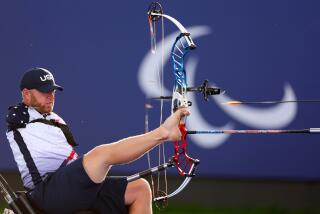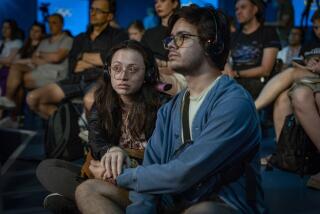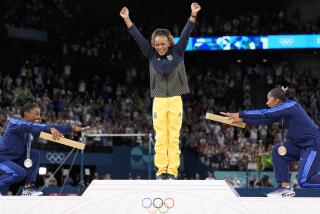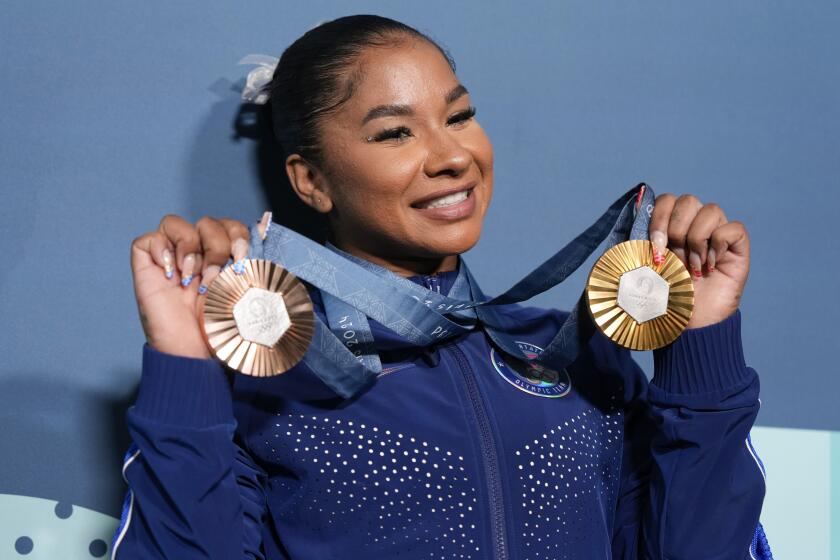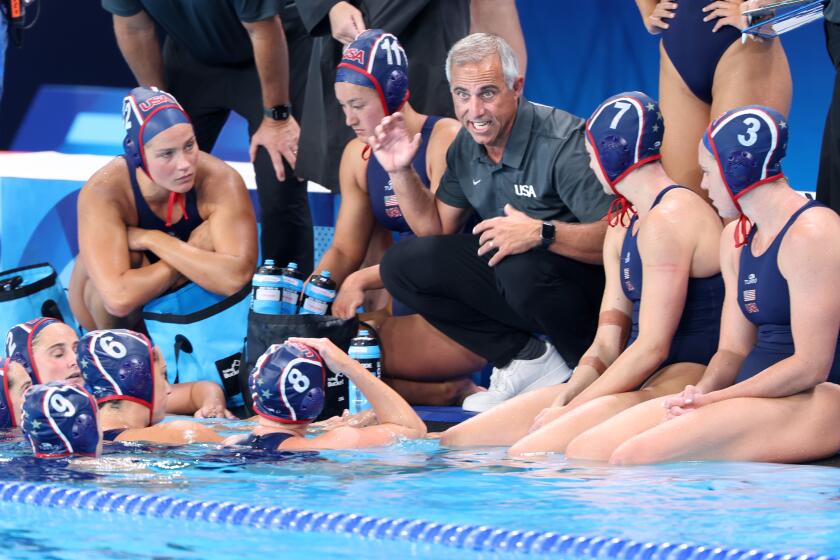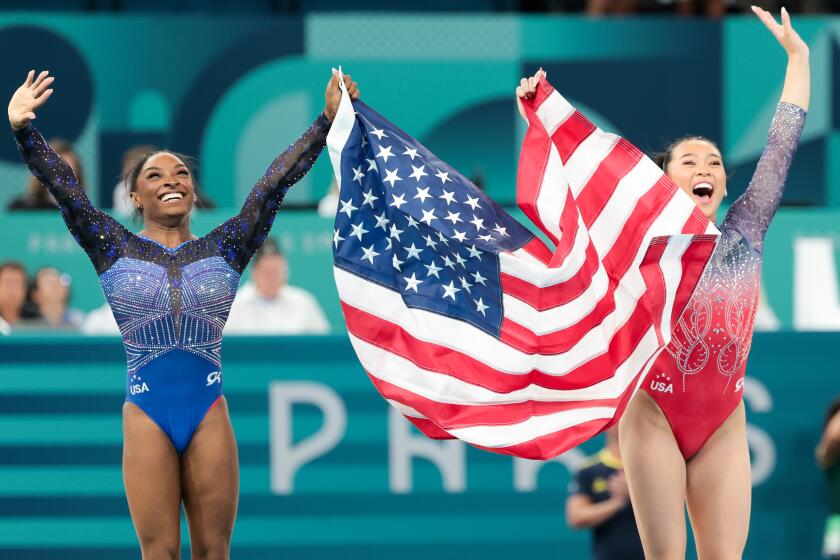Darts finds target audience in England, under the Olympic radar
BLACKPOOL, England — While Adam Scott was squandering a seven-stroke lead in the British Open on Sunday, a few miles up the road in Blackpool, Colin Osborne was letting a comfortable lead of his own slip away.
Scott’s fade took place in the final round of one of golf’s four major tournaments, in front of a standing-room-only crowd and an international television audience of millions.
Osborne’s choke job occurred in the first round of the Betfair World Matchplay — a darts tournament — before a standing-room-only crowd and a national television audience of several hundred thousand.
Photos: Betfair World Matchplay Dart Tournament
And if you think comparing a golf championship to a darts tournament is a bit daft, then you’ve never been to a tournament in Britain, where, on the eve of the London Olympics, many are openly wondering why the sport isn’t in the Games.
“There’s an argument to be made,” says David Allen, media manager for the Professional Darts Corp. (PDC), the largest and most lucrative darts circuit in the world. “If archery is in the Olympics — which is a similar discipline; you’re standing and you aim at a target — there’s nothing to say that darts shouldn’t be.”
Actually, there’s a lot to say that darts shouldn’t be. Because although the competition is as fierce as any archery event this side of “The Hunger Games,” that’s only a small part of what has made darts so popular here.
In fact, the best thing about the sport may be the fans, many of whom come dressed in an array of elaborate and complicated costumes that leave the crowd looking like a Halloween party.
The second-best part is the beer.
Pitchers and pitchers and pitchers of beer.
Darts was born in a pub, making beer a part of its heritage. That also explains why the 116-year-old ballroom where the World Matchplay is being held is filled with dozens of long tables laid out perpendicular to the stage, leaving the room looking more like a drinking hall than a sports arena.
As a result, most of the 2,000 spectators, who paid nearly $40 a ticket, must turn to the left or right to follow the competition. But have we mentioned there’s beer?
“There’s the darts and then the beer; it’s all hand in hand,” says Gareth Frank, a 32-year-old banker from northeast England who was wearing a teddy bear outfit, complete with removable head.
“It makes the atmosphere,” agrees Keith Darling, a 32-year-old from Scotland who identified himself as a shepherd but came dressed as a Smurf.
It all contributes to a raucous atmosphere PDC Chairman Barry Hearn calls “sportsentertainment,” but one that might remind many in the U.S. of professional wrestling.
And at times it appears as if the competitors are the only ones who aren’t part of the circus.
Most of the players dress conservatively, in bowling shirts adorned with sponsors’ patches that leave them looking a bit like NASCAR drivers. They also sport descriptive nicknames such as “The Bronzed Adonis,” “The Dutch Destroyer” and, in an ironic nod, “Over the Top,” and enter the arena — flanked by a model in a skintight mini-dress — while a carefully selected theme song plays at ear-rattling volume.
But once the darts start flying, it becomes serious business.
If it all sounds carefully choreographed, it is. Darts is Britain’s most popular indoor sport, drawing live crowds of as many as 10,000, and it is primarily a TV series, with about 700 hours of live programming per year drawing satellite TV audiences that trail only Premier League soccer.
The credit for that goes to Hearn, a 64-year-old former accountant who became a sports agent and promoter in the mid-1980s, touting everything from snooker to fishing. He added darts in 2001 and four years later, with the pastime still struggling for a foothold in a crowded sports marketplace, Hearn introduced Premier League Darts, a traveling circuit of 15 tournaments matching the top players.
The PDC has never looked back, quickly expanding beyond its working-class roots to embrace an eclectic fan base that includes not only blue-collar laborers but bankers, athletes, even royalty, with Prince Harry having attended a tournament or two.
“It’s really exploded into something of a phenomenon,” Allen says. “That is the biggest party in that town, that is the biggest event in that town, at that time. So each town will almost try to outdo the last one.
“It’s like a rock tour.”
And, some argue, that spotlight has robbed the sport of its tradition and charm.
Richard Orme, who grew up watching darts on the tiny family television just outside Birmingham, remembers when players would compete with a cigarette between their lips and a beer in their hands.
“That was awesome. Proper atmosphere,” he says. “You could have stood your beer on top of their beer belly. They’d be sweating absolutely profusely. And that was it.
“If you look at the average scores from that era to today, it’s not like the standard’s greatly increased. There was probably more of a fanatical following back then.”
Fanatical, yes. But the crowds, like the prize-money purses, were much smaller.
At the time, the national finals were sponsored by a tobacco company and one of its champions was Jocky Wilson, who smoked up to 50 cigarettes a day and often drank more than a dozen pints of beer during a match. He died of lung disease two days after his 62nd birthday, but not before joining 15 other top players who broke away from the British Darts Organization to form their own group, which eventually became the PDC.
Now, two decades later, smoking is banned where the PDC competes. And Sky Sports, the satellite service that televises the tournaments, has stopped the players from drinking anything stronger than water while onstage.
The trade-off has more than paid off for many of the players, such as 15-time world champion Phil Taylor, who earned more than $938,000 last year. And those checks could get a lot bigger this year when the PDC will hand out nearly $8 million in prize money at tournaments that are expected to draw more than 250,000 spectators combined.
Still, while the sport’s rough edges have been smoothed over and the fan base gentrified, the players aren’t much different from those who went before them.
The stocky Taylor, for example, dropped out of school at 16 and worked for about $80 a week making ceramic handles for toilet tissue dispensers. Andy Smith, a hulking man with a bald head and an ample belly, was a farmer, then a logger before turning to darts. And Mark Walsh, the guy who rallied past Colin Osborne, once made filing cabinets.
Few spot welders get the kind of reception Walsh got after Sunday’s win, though, when he spent several minutes being congratulated by fans before leaving the stage with a red lipstick mark in the shape of a kiss on his left cheek.
So naturally he bristles when asked whether darts players should be viewed in the same light as those who will march into the Olympic Stadium during Friday’s opening ceremony.
“Of course they’re athletes,” says Walsh, a 47-year-old father of five. “Professional darts players train every day. They’ve got to stick four, five, six hours a day on the boards, practicing. So in that way they’re athletes.
“Just because you can’t run 100 meters in 10 seconds like Usain Bolt doesn’t mean you’re not an athlete.”
More to Read
Go beyond the scoreboard
Get the latest on L.A.'s teams in the daily Sports Report newsletter.
You may occasionally receive promotional content from the Los Angeles Times.
